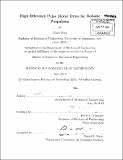| dc.contributor.advisor | David L. Trumper. | en_US |
| dc.contributor.author | Sun, Zhen, M.S. Massachusetts Institute of Technology | en_US |
| dc.contributor.other | Massachusetts Institute of Technology. Department of Mechanical Engineering. | en_US |
| dc.date.accessioned | 2013-10-24T17:48:08Z | |
| dc.date.available | 2013-10-24T17:48:08Z | |
| dc.date.copyright | 2013 | en_US |
| dc.date.issued | 2013 | en_US |
| dc.identifier.uri | http://hdl.handle.net/1721.1/81719 | |
| dc.description | Thesis (S.M.)--Massachusetts Institute of Technology, Dept. of Mechanical Engineering, 2013. | en_US |
| dc.description | Cataloged from PDF version of thesis. | en_US |
| dc.description | Includes bibliographical references (p. 155-156). | en_US |
| dc.description.abstract | The goal of this research is to improve the power efficiency of robotic locomotion through the use of series elastic actuation, with a focus on swimming motion. To achieve high efficiency, electromechanical drives need to be actuated at high speed and low torque. However, in many robots, the drives are actuated in a low speed and high torque mode, resulting in lower efficiency. Implementing gear trains is one option to rise the input speed and lower the input torque. However gear trains have their own loss which are particularly severe at high gear ratios, and are not back drivable in some cases. In this thesis, we envision and design a new pulse drive type of series elastic electromechanical actuators that seeks to break such tradeoffs and improve overall robotic propulsion drive efficiency. An energy storage element, such as a spring, is installed between the EM actuator and the load. In the fast actuation phase, a pulse displacement/ torque trajectory is applied to the actuator shaft so that the spring is rapidly charged with potential energy. In the slow driving phase, the actuator shaft is locked by a low power mechanical latch and the spring slowly transfers energy into the load. We analytically determine that the most efficient pulse condition is reached when the frequency of the pulse trajectory is close to the natural frequency of the actuator inertia-spring system. Our first low power hardware demonstration without the gearbox transmission shows that the pulse drive achieves an energy efficiency of 80% compared to an efficiency of 50% achieved in the conventional direct drive where an electromechanical actuator is driving a viscous load equal to its own motor constant. Another low power hardware demonstration using gear motors at two loads, whose impedances are 10 times and 20 times as high as the driver motor constant, shows that the pulse drive using a motor with a one-stage gearbox transmission achieves an efficiency of 50%, which are approximately 20% higher than the conventional drive with either a one-stage or a two-stage gearbox transmission. An analytical study on the influence of motor size shows that the efficiency gain of the pulse drive becomes larger at smaller motors and that the best option for the pulse drive is to use a motor with a one-stage gearbox. In a third hardware demonstration, we scale up the power level to match that of a small robotic fish, and use a real viscous load. By using the same brushless motor with a one-stage gearbox, we achieve a pulse drive efficiency of 70% compared to 15% in the conventional gear drive. Some potential targets are robots with cyclical propulsions and high impedance load, e.g., tail actuation in fish-like swimming robots, wing actuation in flying robots and crawling and other motions in snake-like robots. | en_US |
| dc.description.statementofresponsibility | by Zhen Sun. | en_US |
| dc.format.extent | 156 p. | en_US |
| dc.language.iso | eng | en_US |
| dc.publisher | Massachusetts Institute of Technology | en_US |
| dc.rights | M.I.T. theses are protected by
copyright. They may be viewed from this source for any purpose, but
reproduction or distribution in any format is prohibited without written
permission. See provided URL for inquiries about permission. | en_US |
| dc.rights.uri | http://dspace.mit.edu/handle/1721.1/7582 | en_US |
| dc.subject | Mechanical Engineering. | en_US |
| dc.title | High efficiency pulse motor drive for robotic propulsion | en_US |
| dc.type | Thesis | en_US |
| dc.description.degree | S.M. | en_US |
| dc.contributor.department | Massachusetts Institute of Technology. Department of Mechanical Engineering | |
| dc.identifier.oclc | 861005942 | en_US |
